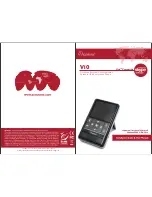
Chapter 15-Users, Connections, and Notes
Polycom, Inc.
15-7
2
The
RMX
searches its records to find the
FQDN
that is associated with the
application-
user’s
name.
3
If the
FQDN
in the received certificate matches that associated with
application-user
, and
the password is correct, the connection proceeds.
Guidelines
•
Application-users
are only supported when
TLS
security is enabled and
Request peer
certificate
is selected.
TLS
security cannot be disabled until all
application-user
accounts
have been deleted from the system.
•
For
Secure Communications
, an administrator must set up on the
RMX
system a machine
account for the
CMA/DMA/XMA
system with which it interacts. This machine account
must include a fully-qualified domain name (
FQDN
) for the
CMA/DMA/XMA
system.
•
Application-user
names are the same as regular user names.
Example:
the
CMA
application could have an
application-user
name of
CMA1
.
•
The
FQDN
can be used to associate all user types:
Administrator
,
Operator
with the
FQDN
of a server.
•
Multiple
application-users
can be configured the same
FQDN
name if multiple
applications are hosted on the same server
•
If the system is downgraded the
application-user’s FQDN
information is not deleted
from the
RMX
’s user records.
•
A
System Flag,
PASS_EXP_DAYS_MACHINE,
enables the administrator to change the
password expiration period of
application-user’s
independently of regular users. The
default flag value is 365 days.
•
The server hosting an
application-user
whose password is about to expire will receive a
login response stating the number of days until the
application-user’s
password expires.
This is determined by the value of the
PASSWORD_EXPIRATION_WARNING_DAYS
System Flag
. The earliest warning
can be displayed 14 days before the password is due to expire and the latest warning
can be displayed 7 days before passwords are due to expire. An
Active Alarm
is created
stating the number of days before the password is due to expire.
•
The
MIN_PWD_CHANGE_FREQUENCY_IN_DAYS
System Flag
does not effect
application-user
accounts. Applications typically manage their own password change
frequency.
•
If an
application-user
identifies itself with an incorrect
FQDN
, its account will not be
locked, however the event is written to the
Auditor Event File
.
•
If an
application-user
identifies itself with a correct
FQDN
and an incorrect password, its
account will be locked and the event written to the
Auditor Event File
.
•
An
application-user
cannot be
the last administrator in the system. The last administrator
must be regular user.
•
User names are not case sensitive.
Monitoring
•
An
application-user
and its connection is represented by a specific icon.
Active Directory
•
When working with
Active Directory
,
CMA,
DMA,
and
XMA
cannot be registered
within
Active Directory
as regular users.
CMA
and
DMA application-users
must be
manually.
Summary of Contents for RealPresence 2000
Page 26: ...RealPresence Collaboration Server RMX 1500 2000 4000 Administrator s Guide xxiv Polycom Inc...
Page 842: ...RealPresence Collaboration Server RMX 1500 2000 4000 Administrator s Guide 23 60 Polycom Inc...
Page 962: ...RealPresence Collaboration Server RMX 1500 2000 4000 Administrator s Guide E 4 Polycom Inc...
Page 968: ...RealPresence Collaboration Server RMX 1500 2000 4000 Administrator s Guide F 6 Polycom Inc...
Page 1128: ...RealPresence Collaboration Server RMX 1500 2000 4000 Administrator s Guide J 18 Polycom Inc...
















































